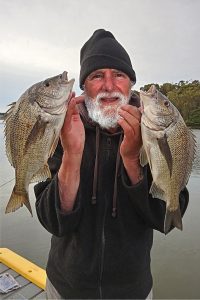
Martinus de Lange with a pair of the bream he caught early last week from the Deakin University jetty at Warrnambool.
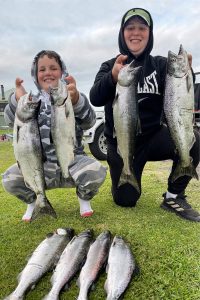
Joseph and Ashton Ardiri with the chinook salmon they caught at Lake Bullen Merri (Picture: Kane Ardiri).
Warrnambool
Heading down to Warrnambool’s Hopkins River in the pre-dawn darkness with a good supply of scrubworms for bait early last week, Martinus de Lange was on the Deakin University jetty by dawn’s first light, hopeful of catching a good size bream or two.
He caught six as it turned out, the biggest a beauty of 40 cm, most of them shortly after daybreak. After that though, the fish on offer decreased in size, and included some that were undersize.
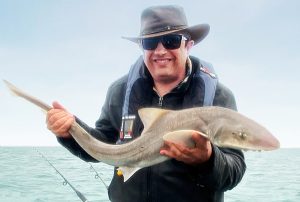
Alan Cook with the gummy shark he caught off Clifton Springs (Picture: Stephen Goodfellow).
Off the Beach
Fishing Wednesday morning’s low tide at Jan Juc Beach, Ray Millman was surprised to find the beach substantially denuded of sand. However, he found a deep channel in front of the creek, from which he caught several Australian salmon on a lure.
Returning again in the evening, this time with some of the salmon he’d caught earlier as bait, he was hoping for action from the bigger fish this area is known to produce. In fact, he caught a gummy shark of about 5 kg and pulled the hook on possibly another.
However, with the channel deep enough to expose the reef below, Ray was constantly being snagged. So, eventually denuded of sinkers, he was forced to retreat.
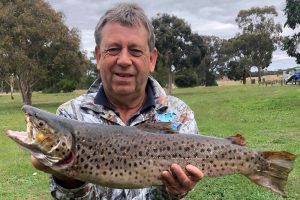
Trevor Perry with a nice brown trout from Tullaroop Reservoir (Picture: Kevin Wild).
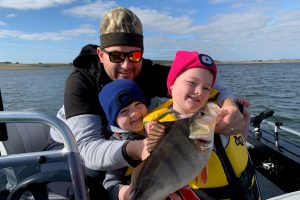
Stephen Eales, with son Mason 3, and Lily 5, with a sample of Stephen’s redfin catch.
Corio Bay/Bellarine Peninsula
Stephen Goodfellow had long tried to coax his brother-in-law, Alan Cook out in his boat, the latter preferring to keep his feet on dry land. But, with a break in the weather, an agreement was reached and the pair set off from Clifton Springs.
However, it was Alan who caught the fish; first an Australian salmon, from which Stephen fillet took a fillet and baited it on Alan’s line, which in turn tempted a fair size gummy shark. Suffice to say that Stephen now has a willing fishing companion.
Whiting are about, and on Friday afternoon, Andrew Johnson and wife Jenny found a good patch in 4 metres of water inshore from the Portarlington mussel farm where they had no problem taking bag limit catches.
Fishing in much the same area on Saturday, Andrew – this time with Pete Dawson – found them a little harder to find. Never the less, after a series of moves, located a good pod of fish in 6 metres of water, each taking their respective bag limits.
Rod Ludlow of Beachlea Boat Hire at Indented Head reports that although whiting didn’t appear in clients catches last week, and squid were scarce, flathead were plentiful enough with clients having no trouble catching them on the drift out in the deeper water
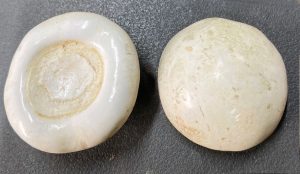
Gastroliths from a large freshwater crayfish, found within the stomach of a Murray cod.
Freshwater
Kane Ardiri, along with sons Joseph and Ashton, made the journey to Lake Purrumbete on Saturday, where – fishing in 13 metres of water – they caught 8 chinook salmon to 2 kg using pilchard fillets for bait.
They also caught a number of redfin on live minnow.
Fishing Wurdiboluc Reservoir on Saturday Simon Werner found the fishing a little slow, but he caught one rainbow trout of a kilogram on a mudeye suspended under a float, and a 600-gram redfin while casting a Rapala CD9 in the rainbow trout pattern.
Kevin Wild of the Maryborough Angling Club reports that members had a competition on Tullaroop Reservoir over the weekend with Stephen Eales taking the biggest redfin at 40 cm. That was followed by John Rivett with a redfin of 36 cm.
Brown trout to 50 cm were also caught by Trevor Perry and Colin Robertson, with even bigger specimens seen to be captured by visiting anglers who weren’t in the club.
Darcy asks:
My father Murray and I recently caught some cod from the Murray River, and among items found in one of their stomachs, were these two mushroom shaped objects, each an inch across. Do you know what they are?
Darcy, I forwarded the pictures you took of those objects to Freshwater Fisheries Manager, Dr Taylor Hunt who advised that these are actually crayfish gastroliths and forwarded this link: http://museum.wa.gov.au/explore/blogs/andrew-hosie/why-freshwater-crayfish-don-t-need-milk-healthy-bones
Gastroliths are formed in a remarkable physiological process conserving calcium to maintain the strength of their exoskeleton and claws, for unlike seawater, freshwater has very little dissolved calcium. So, to retain calcium, freshwater crayfish form these gastroliths in moulting, re-absorbing calcium carbonate from the exoskeleton prior to shedding.
